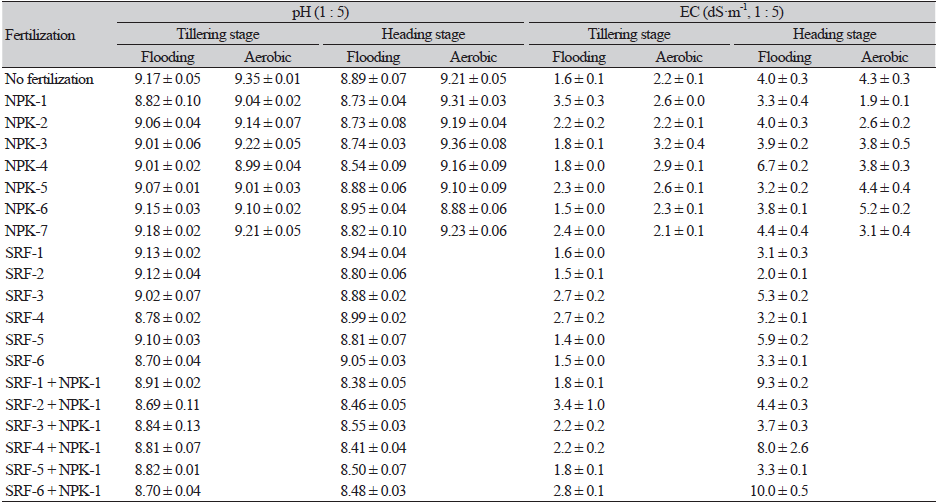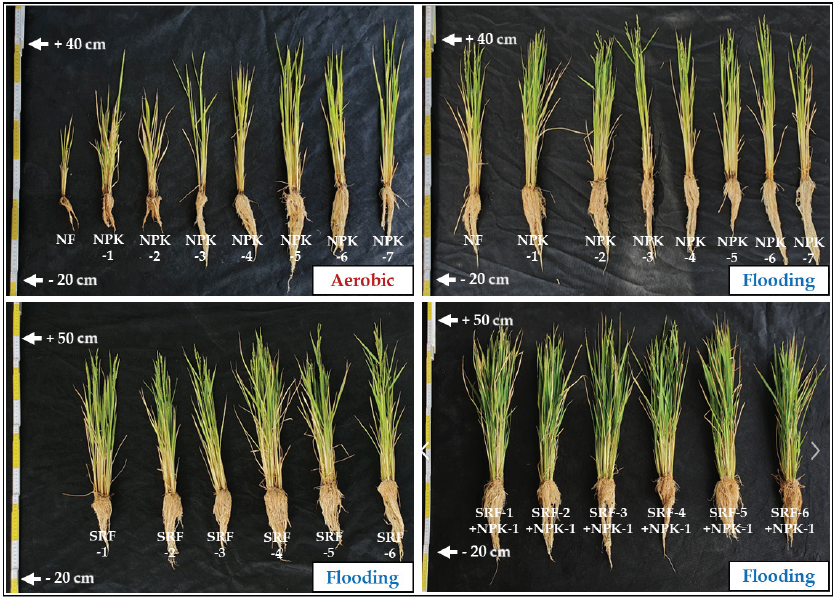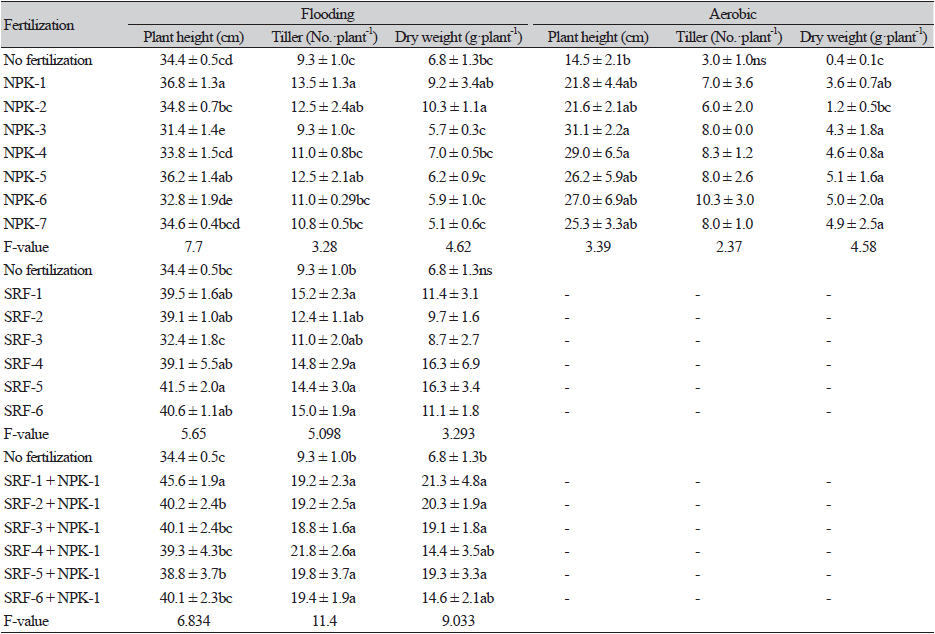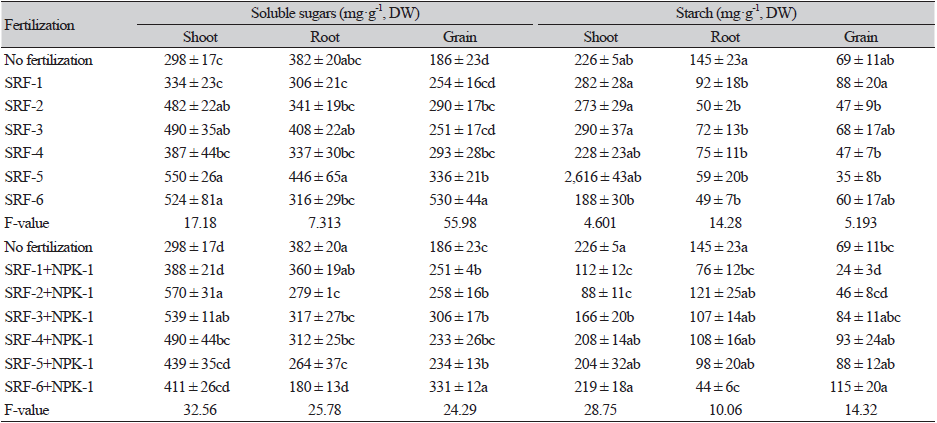Introduction
The Food and Agriculture Organization (FAO) forecasted a 34% increase in the world population by 2050 (FAO, 2009), and this issue has led to a demand of approximately 43% increase in important cereal crop productivity such as rice (Powell et al., 2012). Of major crops, rice, a food for approximately half of the world population, should be increased by 0.6 - 0.9% annually until 2050 to satisfy global demand (Carriger and Vallee, 2007). Despite of a necessity of yearly 2.4 % yield enhancement until 2050, the one third of global rice production area is unfavorable conditions including extreme alkaline and or salinity to act as a limiting factor (Ray et al., 2013; Haefele et al., 2014). An alkali stress is a concern affecting negatively from cellular metabolism to growth and yield of agricultural crop plants (Wang et al., 2012), and, in particular, the higher soil pH (more than 8.0) leads to a poor rice growth and development by the restricted acquisition of essential elements including nitrogen and is followed by a toxicity and/or deficiency of certain nutrient (Msimbira and Smith, 2020).
Rice plants requiring more water compared to other cereal crops (Pimentel et al., 2004) is sensitive to water shortage during the whole growing season, and even moderate drought condition significantly and frequently reduce the growth and yield of rice (Farooq et al., 2009). Babu et al. (2000) demonstrated an effect on diverse soil water potentials; reduced germination, early seedling growth, vegetative growth (tillering) and yield. In addition, a limited water supply resulted in delayed flowering and lower grain filling (Farooq et al., 2009). Soluble carbohydrates play an important role as an osmoregulatory against a variety of abiotic stress including alkaline/salinity, and are largely accumulated to mediate physiological perturbation of plants (Kaplan and Guy, 2004; Skirycz et al., 2010; Siaut et al., 2011; Wang et al., 2013). In the context of the influence of adverse soil conditions, rice production in middle East Asia like the United Arab-Emirates (UAE) is an extremely challenging work due to higher soil pH and limited irrigation water as well as higher temperature. The climate of the UAE located in arid area is characterized by extremely higher temperature (daily average of 46℃) and humidity, and an imbalance between precipitation (yearly rainfall less than 160 mm) and evaporation. Even, soil texture of most of soils is sandy soil, which is showing greater permeability and lower water- and nutrients-holding capacity (Shahin and Salem, 2015).
Therefore, the current study has tried to evaluate the effect of diverse combinations of water and nutrients and finally establish the optimal methodology for rice production in an arid area (higher soil pH). To achieve our goals, we performed the UAE-constructed experimental field, and investigated soil chemical adjustment, the growth and carbohydrate production of rice plants.
Materials and Methods
Experimental setup and treatment
The current study was conducted at the Center for Agricultural Innovation (CAI), Sharjah, United Arab Emirates (25°16'09.1"N 55°55'49.7"E) from January to April, 2022. The seeds of rice (Oryza sativa L. cv. Asemi, alkaline-resistant) were germinated and uniformly growing twenty days-old seedlings were carefully transplanted into a Wagner pot (a/5,000, 3 plants·pot-1). The pH of soil used for this study was 9.35 ± 0.01 (extreme alkaline), which is indicating inadequate condition for rice production. Water was supplied with a drip irrigation including different rates of NPK or slow release fertilizer (SRF), and divided into two different rates of watering, 1) flooding (300 - 400 mL, 2 times·day-1) and 2) aerobic (150 - 200 mL, 1 times·day-1). For chemical fertilizer (NPK) application, ammonium sulfate ((NH4)2SO4), potassium phosphate (KH2PO4) and potassium sulfate (K2SO4) were used as a source of N, P2O5 and K2O, respectively. A slow release fertilizer (SRF) containing different combinations of NPK was also applied. The detailed recipe is described on Table 1, and those are divided into three groups by fertilization; Group-A (NPKs), Group-B (SRFs) and Group-C (SRFs + NPK-1).
Table 1. Recipe for watering and fertilization.
|
|
N, ammonium sulfate; P, potassium phosphate; K, potassium sulfate; SRF, slow release fertilizer. |
Sampling, agronomic parameters and C/N analysis
Soils and rice from each treatment group were carefully taken at the tillering and heading stages. The soil samples (n = 3) were air-dried at ambient temperature, and the pH and electrical conductivity (EC) were measured with a potable pH/EC meter after 30 min of shaking (soil : ddH2O, 1 : 5). The agronomic parameters from the sampled rice plants (n = 3) were firstly measured, divided into the shoots, roots and grains (heading stage only), ground after oven-dried (80℃), and used for further analysis. The dried rice samples (0.1 g) were put in the customized containers, and were combusted at high temperature (1,000℃) (CN auto-analyzer, Primacs SNC 100, SKALAR, Breda, Noord-Brabant, Netherland). Total carbon and nitrogen were measured by non-dispersive infra-red (NDIR) and thermal conductivity detector (TCD) detectors, respectively.
Determination of total soluble sugar and starch
In order to determine carbohydrate contents, the dried samples (0.1 g, shoots/roots/grains) were first boiled with 10 mL of 80 % ethanol in boiling water. The alcoholic extracts were evaporated under nitrogen stream, and the residues were re-dissolved with distilled water. The residue was digested with 2 mL of 9.3 N HClO4, and the supernatant after a centrifugation was used for the determination of starch. Water extracts were mixed with 2 volumes of 0.2% anthrone in a concentrated H2SO4 followed by estimation of carbohydrate as described by Roe et al. (1955). The colorimetric quantification of the extracts was measured at 630 nm with a spectrophotometer (UV-1900i, Shimadzu, Kyoto, Japan). Glucose was used as standard for both soluble sugars and starch.
Statistical analysis
An analysis of variance was performed to compare the differences between treatments using a statistical program (R version 4.0.3, RStudio, Inc., Boston, MA, USA). Data were analyzed in a completely random design using ANOVA, and, if p < 0.05, were subjected with Tukey-HSD test to detect significant differences among the means.
Results and Discussion
Soil pH and EC
The soil pH used in this study was an extremely stronger alkaline (pH 9.35). An electrical conductivity (EC) was also relatively higher (1.69 ± 0.71) considering that the soil structure was sandy. The soil contained great amount of sulfur (145 ± 37 mg·L-1) and chloride (76 ± 16 mg·L-1) ions, whereas essential elements such as NO3, PO4, K and Ca were deficient for normal rice growth (Table 2). Water management and different types and rates of chemical fertilizers were employed as a measure to adjust soil pH and EC, and monitored both tillering and heading stages. The soil pH was not adjusted by different types of water and fertilization managements (Table 3). The EC was unchanged (tillering stage) or fluctuated (heading stage) under an aerobic soil condition regardless of the type of fertilization. In contrast, the continuous flooding (800 mL·day-1) resulted in the significant increase by fertilization at heading stage.
In this study, the water and nutrient managements did not represent any effect on adjusting high saline soils containing Na and Cl, and thus it is suggested that, prior to improving chemical properties, it is necessary to improve soil structure for promising rice production.
Rice growth and soluble carbohydrates
The growth parameters measured at the heading stage remarkably differed from different types of water management, which indicated that the flooding was significant greater compared to the aerobic condition (Table 4; Fig. 1). Different rates of chemical fertilization (NPK-1 and -5) showed significant differences in growth parameters compared to no fertilization in the flooding condition, whereas the treatments (NPK-3 and -4) were greater in the aerobic condition. Therefore, an adjustment of chemical fertilizer (N, P or K) resulted in marginal effect, and, overall, the growth of rice plants largely depended on both water and nutrient managements. The reduction in growth and development of rice plants frequently takes place in higher salt-containing agricultural lands (Zeng et al., 2003). The application of different types of SRFs treatment didn’t show significant effect on dry weight, whereas the SRFs containing higher N level markedly enhanced tillering compared to no fertilization. The supply of fertilizer in reclaimed saline soil increased growth and yield with a mitigation of salinity stress (Rady, 2012), and we also observed that the combination of SRFs and NPK-1 revealed the clear effect on the improvement of all growth parameters.
Based on the result of growth parameters, soluble carbohydrates, soluble sugars and starch, were measured from the shoot, root and grain of rice plants treated with SRFs and SRFs + NPK-1 at the heading stage (Table 5). Indeed, SRFs (-2, -5, and -6) containing the relatively higher N resulted in significant abundant level of soluble sugars in the shoot and grain, whereas those in the root was not differ. In contrast, the level of starch was not remarkable in the shoot and grain between treatments, however, an abundance was significantly reduced in the root. An application of SRFs + NPK-1 also represented the similar trends to SRFs treatments. Indeed, soluble sugars were greatly accumulated in the shoot and grain by an input of SRFs + NPK-1, on the other hand, the level in the root was largely decreased in some treatments. The concentration of starch showed organ-specific different patterns by treatment, although SRF-1 + NPK-1 led to the noticeable decrease in all organs compared to no fertilization. An accumulation of non-structural carbohydrates provides an energy for suitable plant growth and development, and, moreover, those play an essential role to regulate the homeostasis and protect from the damage against adverse growth environments like salinity (Khelil et al., 2007; Bagheri and Sadeghipour, 2009; Naureen and Naqvi, 2010). In this study, we observed a marked accumulation of soluble sugars in the shoot and grain of rice plants by most of the fertilization group, by contrast, showed a decreasing pattern in the root. A large accumulation of soluble sugars in the shoot and grain was considered as a result of higher photosynthetic activity, and the driving force was due to the N supply by fertilization. The limited photosynthesis under salinity caused a decrease in the carbohydrate level and followed by reduced plant growth (Pattanagul and Thitisaksakul, 2008). Overall, the level of starch remained unchanged or smaller fluctuation in the shoot and grain. Starch biosynthesis is greatly affected by K, an essential element to activate starch biosynthetic-enzymes, however the uptake of K is frequently limited under salinity (Moradi et al., 2003; Dkhil and Denden, 2010). The shortage of an acquisition of essential mineral nutrients in plants is as a consequence of an antagonism by higher Na+ and Cl- under salinity, and this results in an adjustment of carbohydrate partitioning between source and sink tissues to increase root biomass (Hermans et al., 2006). This study also confirmed that starch in root was significantly accumulated under no fertilization. Therefore, the carbohydrate metabolism such as synthesis and partitioning under salinity was in line with our observation. Our result demonstrated that the reduced carbohydrate production could be partly compensated by fertilization, and the effect of fertilization was noticeable in soluble sugars.
Conclusion
The current study was tried to investigate the effect of an application of chemical fertilizers (various types and rates) to promote rice production in arid areas, where have higher soil pH due to salinity. Any chemical fertilization was not effective to adjust soil pH. Rice growth was noticeably promoted by fertilization, especially slow release fertilizers (SRFs) and SRFs + NPK-1, with sufficient watering (flooding). Therefore, despite of a fertilization with an irrigation could be a great challenge to cultivate rice, it is firstly required to amend soil physical structure to promise suitable rice production.










